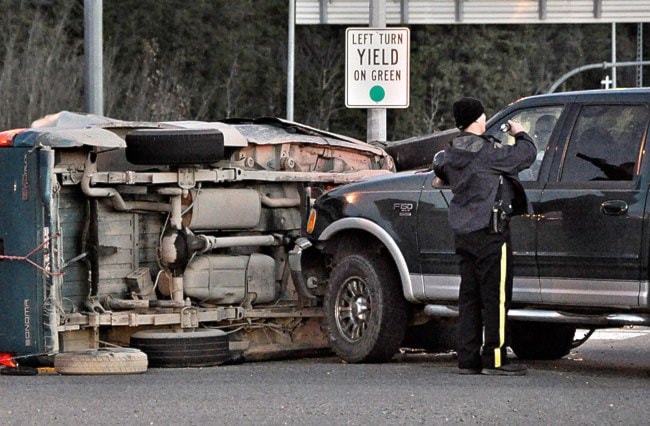Two drivers whose vehicles collided at the intersection of Two Mile Hill and the Alaska Highway on Sept. 28 both claimed to have the green light.
For the city, it was a signal to look into the claim.
“As soon as someone gives us a complaint like that, we can’t ignore it,” said Larry Shipman, a technologist with the city’s engineering department. The complaints came on Oct. 2, he said. “We have to look into it right away.”
So, last week, city employees tested the intersection to see if it was possible for both lights in opposite directions to be green. They concluded it isn’t.
A traffic control box monitors all the channels at an intersection. There are certain things that aren’t allowed to happen. One is two green lights in opposite directions. If that did occur, the whole intersection would start to flash, said Shipman.
Officials test all city intersections every year, but did a special inspection just because of these complaints, said Shipman.
The complaint that drivers travelling in opposite directions at that intersection have both received green lights is not common, he said. But it is not new.
Five years ago this month, Clara Rutherford was driving down from Granger. She was volunteering for the food drive and had just dropped off another volunteer at home. Her grandson and one of his friends were with her in the car.
As she was turning left towards Porter Creek, her car T-boned another vehicle coming up from downtown. A witness said both drivers had the green light, said Rutherford. And her passengers agreed - they were almost old enough to get their licences, and were carefully watching how she drove, she said.
No one was seriously injured, but her car was a write-off, she said.
The intersection has changed since then. In 2011, the city put in slotted turning lanes at the bottom of Hamilton Boulevard, said Shipman. While the territorial government is responsible for the Alaska Highway, the intersection of Two Mile Hill and Hamilton Boulevard is the city’s responsibility.
Between 2000 and 2009, 248 incidents were recorded as happening at Two Mile Hill. Of those, 53 incident reports mentioned the incident happened at the intersection of Two Mile Hill and the Alaska Highway.
Some multi-vehicle incidents have more than one incident report, said Sebastien Markley with the Yukon Bureau of Statistics. There were no fatalities. Twenty-seven vehicles were totalled and 101 people were injured.
The intersection is much better now, said Rutherford. But there are still concerns.
There is no predictable pattern for the intersection’s traffic lights, said John Hale. The owner of Mile 918 Driver Development has been teaching driving for 20 years. He teaches commercial truck drivers.
Hale estimates about 200 trucks travel through that intersection each day. He drives through that intersection, on average, about 10 times a day, he said.
There are times when Hale is getting ready to turn left, but the light turns red before he can make the turn, he said.
He trains drivers to anticipate what will happen next. It’s almost impossible to do that at that intersection, and that makes it dangerous, he said.
The timing may not always be predictable, but there is a method behind it. The intersection at the Alaska Highway and Two Mile Hill is triggered by a vehicle-activated sensor.
The amount of time a light stays a certain colour depends on the amount of traffic. A driver may be ready to turn left, but if the trigger has already been signalled before they get to the turning lane, they may have to wait through another cycle before they can go.
When no one’s on the road, the lights on Two Mile Hill-Hamilton Boulevard stay on green, said Shipman.
Not every intersection is the same. Some, like the intersection at Two Mile Hill and Chilkoot Trail, are timed according to traffic flow. The lights on main streets always receive the maximum amount of time, he said.
Traffic consultants determine how often lights should change, said Shipman. Maximum times can vary from intersection to intersection. And some lights, like the ones at Main Street and Second Avenue, run on fixed cycles, he said.
Rutherford had nightmares after the accident. She never volunteered for the food drive again. And, for a long time, she would cringe every time she had to cross Two Mile Hill and the Alaska Highway.
She’s still wary of it. “I treat it with extreme caution,” she said.
Contact Meagan Gillmore at
mgillmore@yukon-news.com
